The Rhine. Part 11
Description
This section is from the book "The Rhine - John L. Stoddard's Lectures", by John L. Stoddard. Also available from Amazon: John L. Stoddard's Lectures 13 Volume Set.
The Rhine. Part 11
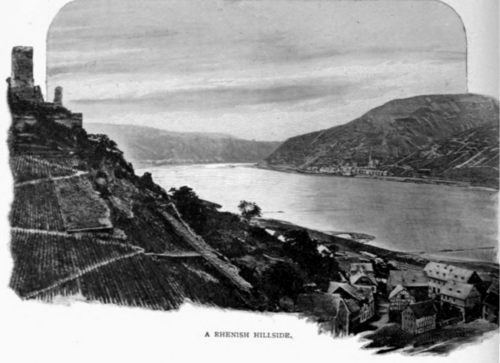
Soon after leaving Mainz, we find ourselves within the region of ruined castles, tenanted only by the genii of the past. From time to time old crumbling walls, or solitary towers, cast their dark silhouettes upon the sky, - some bleak and bare, others concealing their defects with vines and leaves, like Spanish beggars in their tattered mantles.
Many of these castles were formerly the abodes of men who lived by levying duties on the commerce of the river. Like vultures, from their eyries, they watched the boats descend the stream, and if the tribute they demanded was refused them, they promptly attacked the crew, and secured the cargo for themselves.
Among the strongest residences of these robber barons, and even now the largest ruin on the river, is the Rheinfels. Its record is remarkable, for it was the greed and cruelty of the master of this fortress which finally drove his victims to resistance. A league was formed by several Rhenish cities to do away with this unbearable oppression; and under that confederation, the haughty castles one by one went down. It was a bloody task. This stronghold, in particular, withstood a siege of fifteen months and drove back from its battlements an army of twenty-four thousand men; but, finally, its power was destroyed. Nature has charitably thrown over these blood-stained walls a robe of verdure like a mantle of oblivion, and they are now the peaceful home of birds and flowers, which fill the historic courts with song and fragrance. Best of all, the commerce of the Rhine, to-day, sails fearlessly beneath the gloomy towers which threatened once its ruin.
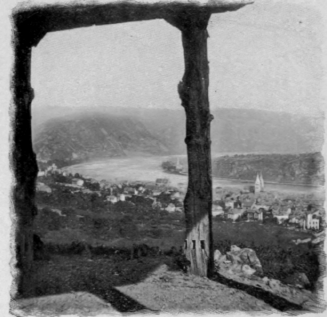
A Bit Of Rhineland.
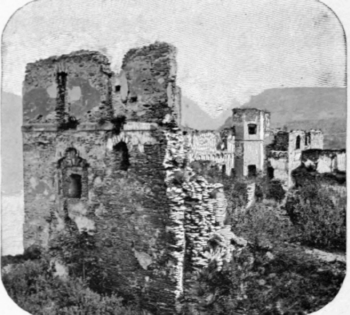
The Rheinfels.
Conspicuous among the castles whose towers fling their shadows on the placid bosom of this river is the Rhein-stein. Its origin is lost in obscurity, but there is evidence that it has kept watch and ward above the Rhine for at least six hundred years. To-day, it is a summer residence of the German Emperor, and, in accordance with his wish, is kept as far as possible in the old style. The walls, for example, are hung with ancient armor, the windows are of stained glass, great shaggy skins adorn the inlaid floor, and even the furniture is antique, collected from old castles or mediaeval convents.

The Rheinstein.
Another prominent ruin attracting one's attention on this journey is the castle of Ehren-fels. It is in reality no older than the Rhein-stein, but, in its mutilated condition, it seems much more ancient. On the occasion of my visit, I clambered up a staircase in the tower and looked out through the casements near the top. The guardian of the place was a plump German matron of such ample girth, that she did not venture to follow me up the stairs; fearing perhaps the fate of the watchman's wife, whose home was in the top of one of these narrow towers, and who there grew so stout that she could neither get down the steps, nor out of the window. When, therefore, her husband died his successor was obliged to marry the widow in her prison.
Not far away one sees upon a tongue of land a tall square tower, which, although fully as old as that of Ehrenfels, was handsomely restored in 1856. The curious legend which adheres to it has stamped forever on its walls the title of the "Mouse Tower." For who does not remember the story of Bishop Hatto, who, in a year of famine, locked a multitude of women and children in one of his barns and set it on fire?
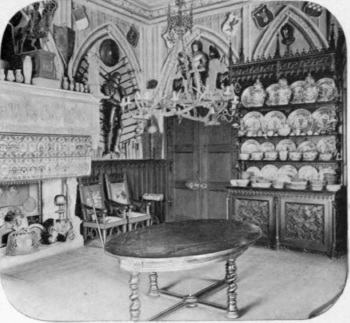
The Interior Of The Rheinstein.
"There," he exclaimed, as he saw the flames, "I have burned up a lot of miserable rats that were good for nothing but to eat corn." Hardly had' he uttered the words, when a servant came running to him and announced that thousands of rats were coming that way. In terror, the bishop hastened to this tower and, barring every hole and window, thought himself secure; but in vain !
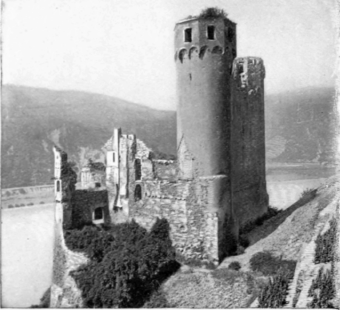
Ehrenfels.
" In at the windows, and in at the door, And through the walls by thousands they pour, And down through the ceiling and up through the floor, From the right and the left, from behind and before, From within and without, from above and below; And all at once to the bishop they go.
Continue to:


